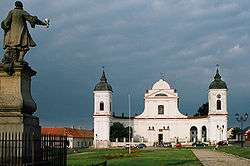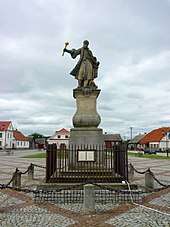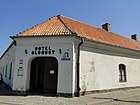Tykocin
Tykocin [tɨˈkɔt͡ɕin] (Yiddish: טיקטין, Tiktin) is a small town in north-eastern Poland, with 2,010 inhabitants (2012), located on the Narew river. Tykocin has been situated in the Podlaskie Voivodeship since 1999. Previously, it belonged to Białystok Voivodeship (1975-1998). It is one of the oldest settlements in the region.
Tykocin | |
|---|---|
 Market Square with the statue of hetman Stefan Czarniecki and the Holy Trinity Church | |
 Flag  Coat of arms | |
 Tykocin | |
| Coordinates: 53°12′11″N 22°46′15″E | |
| Country | |
| Voivodeship | Podlaskie |
| County | Białystok |
| Gmina | Tykocin |
| Established | 11th century |
| Town rights | 1425 |
| Government | |
| • Mayor | Mariusz Dudziński |
| Population (2018) | |
| • Total | 1,980[1] |
| Time zone | UTC+1 (CET) |
| • Summer (DST) | UTC+2 (CEST) |
| Postal code | 16-080 |
| Area code(s) | +48 85 |
| Car plates | BIA |
| Website | tykocin.podlaskie.pl |
History
Middle Ages
The name of Tykocin was first mentioned in the 11th century. Through the 14th century it was a castellany in the Duchy of Masovia on the border with pagan Lithuania. Tykocin received its city rights from prince Janusz I of Warsaw in 1425, but several months later the settlement was transferred to the Grand Duchy of Lithuania (within the Polish-Lithuanian Union) by the Polish king Władysław II Jagiełło. Shortly later, in around 1433, Duke Sigismund Kęstutaitis gave the town along with other surrounding villages to Jonas Gostautas, and it became the most important seat of the Lithuanian Gostautai noble family.
Early modern era

In the 1542, upon the death of Gostautai family's last member, the town was acquired by Polish king and Lithuanian Grand Prince Sigismund II Augustus[2] who had the medieval stronghold remodelled into a Renaissance castle. One of the largest arsenals of Poland was located in Tykocin.[2] It subsequently became a royal town of the Polish Crown, located within the Podlaskie Voivodeship and was eventually awarded to Hetman Stefan Czarniecki for his military service during the Swedish invasion of Poland[3] in 1661. In the 16th and 17th centuries Tykocin was granted new privileges by kings Stephen Báthory and Władysław IV Vasa.[3] Later on, through the marriage of Czarniecki's daughters, it passed to the Branicki (Gryf coat-of-arms) family. From 1513 until the Third Partition of Poland in 1795 Tykocin was a county (powiat) seat.
It was Tykocin, where in 1705 King Augustus II the Strong established the Order of the White Eagle, the highest and oldest Polish order.[3][4]
Most of Tykocin's landmarks was built in this era, including the Holy Trinity Church, monasteries of the Congregation of the Mission and the Bernardines, the former 17th-century military hospital, the synagogue and the statue of hetman Stefan Czarniecki.[3]
Late modern era and recent times
Following the Partitions of Poland Tykocin was annexed by Prussia[2] and Izabella Poniatowska-Branicka sold the town to the Prussian government in 1795. In 1807 it was briefly regained by Poles as part of the Duchy of Warsaw in accordance to the Treaty of Tilsit.[2] In 1815 it became part of the Congress Kingdom of Poland,[2] later on forcibly annexed by Imperial Russia. It was reintegrated with Poland after the country regained independence in 1918. During the interwar period, the population of Tykocin had reached an estimated 4,000 inhabitants. In 1950 Tykocin lost its city rights due to population loss in World War II, only to regain it in 1993. During the war it was occupied by the Soviets from 1939 to 1941 and the Germans from 1941 to 1944.[2]
The Jewish population of Tykocin estimated at 2,000 people was eradicated by Nazi Germans during the Holocaust. On 25–26 August 1941 the Jewish residents of Tykocin were assembled at the market square for "relocation", and then marched and trucked by the Nazis into the nearby Łopuchowo forest,[5][6] where they were executed in waves into pits by SS Einsatzkommando Zichenau-Schroettersburg under SS-Obersturmführer Hermann Schaper.[7] A memorial now exists outside the city for the Tykocin pogrom.
Points of interest
- Tykocin Castle built before 1469, extended in 16th century and partially reconstructed in 2005
- The Baroque Tykocin Synagogue Bejt ha-Kneset ha-Godol, built in 1642, one of the best preserved in Poland from that period and a major tourist attraction.
- A baroque Church of the Holy Trinity and former monastery of Congregation of Mission founded in 1742 by Jan Klemens Branicki
- Baroque Bernardine Monastery from 1771–90
- Monument of hetman Stefan Czarniecki from 1763[3]
- Former military hospital from 1633–1647, the Alumnat, one of the oldest of its kind in Europe, now a hotel
- Baroque manor house Rezydencja ekonomiczna, currently the Center of Culture, Sport and Tourism
- Catholic cemetery, dating back to the 18th century
- Jewish cemetery – one of the oldest in Poland
- Monument of the White Eagle from 1982, referring to the establishment of the Order of the White Eagle in Tykocin in 1705[3]
- Abundance of white storks and their nests in the area
- Church of the Holy Trinity and Narew River Bridge
- Baroque Synagogue
- Castle after reconstruction
 Main altar at Holy Trinity
Main altar at Holy Trinity Former 17th-century military hospital
Former 17th-century military hospital Bernardine Monastery
Bernardine Monastery
Notable individuals
- Joshua Höschel ben Joseph, a Polish rabbi born in Wilno
- Jan Klemens Branicki, Field Crown Hetman of the Polish–Lithuanian Commonwealth
- Bolesław Gebert, Communist Party official
- Łukasz Górnicki, Chancellor of Sigismund Augustus of Poland
- Mikołaj Ostroróg, a Polish-Lithuanian nobleman
- Bogusław Radziwiłł, an Imperial Prince of the Holy Roman Empire
- Janusz Radziwiłł (1612-1655), Polish prince, magnate and Field Hetman of Lithuania
- Paweł Jan Sapieha, Hetman and military commander
- Jan Smółko (b. 1907, AK alias Lokalizator), wife Władysława (b. 1908), Polish Righteous among the Nations – produced over a hundred fake IDs for Tykocin Jews during World War II, based on Catholic parish records.
- Rebecca bat Meir Tiktiner (d. 1550)
- Krzysztof Wiesiołowski
References
| Wikimedia Commons has media related to Tykocin. |
- "Powierzchnia i ludność w przekroju terytorialnym w 2018 roku". Główny Urząd Statystyczny.
- "Tykocin". Encyklopedia PWN (in Polish). Retrieved 9 October 2019.
- "Tykocin – opis miejscowości". Atrakcje Podlasia (in Polish). Retrieved 9 October 2019.
- Tomasz Święcki, Opis starożytnéy Polski, tom I, Zawadzki i Węcki, Warszawa, 1816, p. 420–421 (in Polish)
- (in Polish) "Rocznica zagłady żydowskiego Tykocina," Archived 2012-03-01 at the Wayback Machine (commemoration) Gazeta Wyborcza Białystok, 24 August 2009
- Tykocin na mapie polskich judaików, at www.kirkuty.xip.pl
- Alexander B. Rossino, "Contextualizing Anti-Jewish Violence in the Białystok District during the Opening Weeks of Operation Barbarossa", Polin: Studies in Polish Jewry, Volume 16 (2003)
External links
- Tykocin on the map of Poland, at www.pilot.pl
- Tykocin Synagogue photos, at ddickerson.igc.org
- "Tykocin – news, photos... all about this beautiful town," at www.tykocin1425.az.pl.
- Plac Czarnieckiego 10 Anthropological project: art, history and heritage of Tykocin.
- photos of Tykocin castle and events